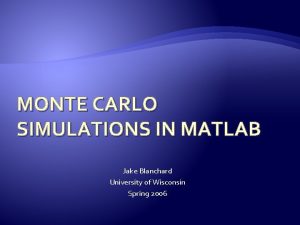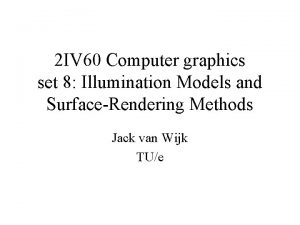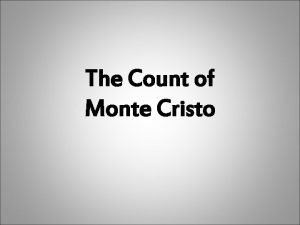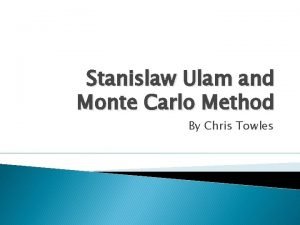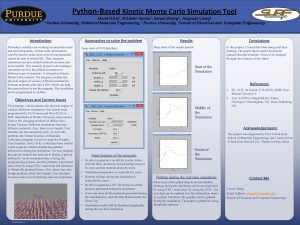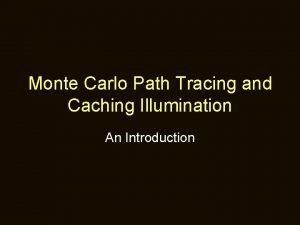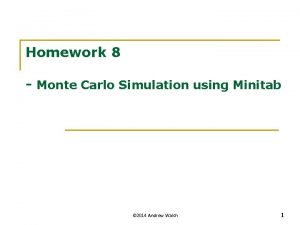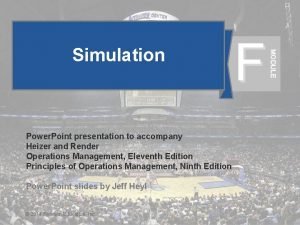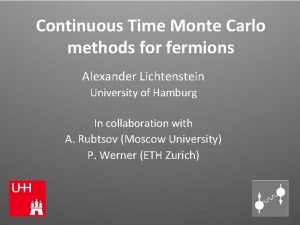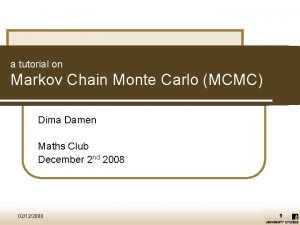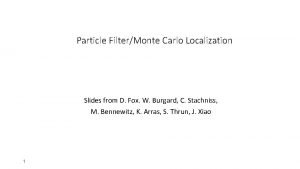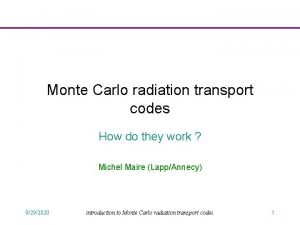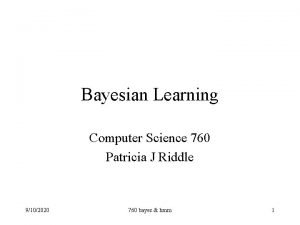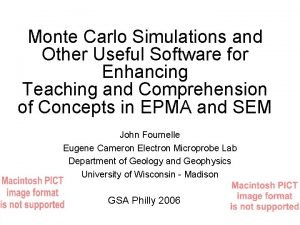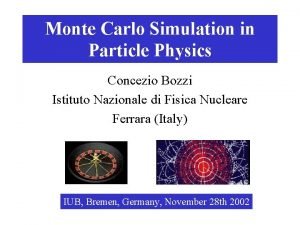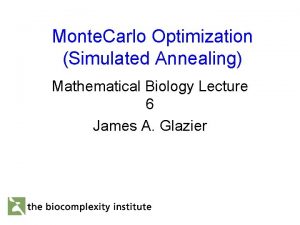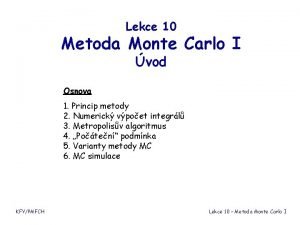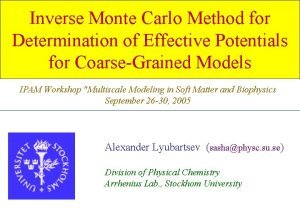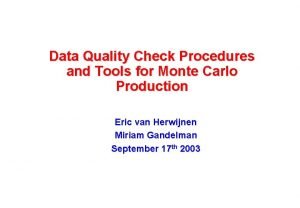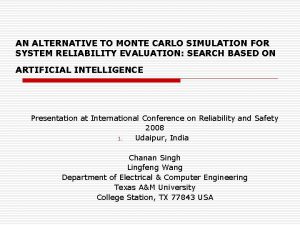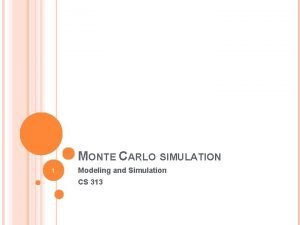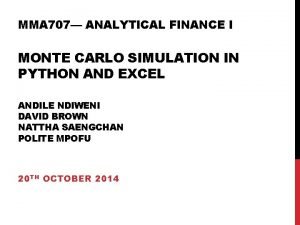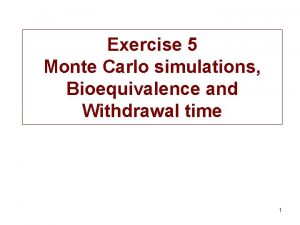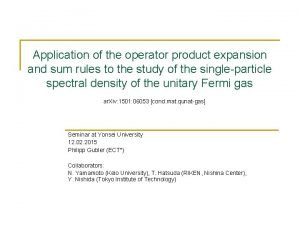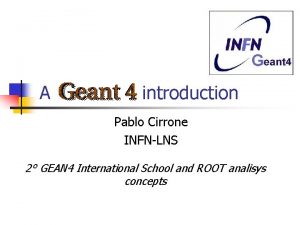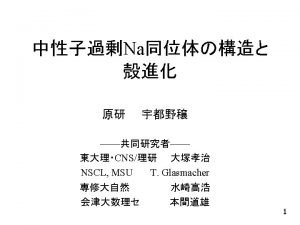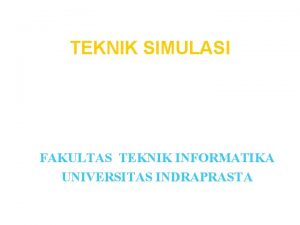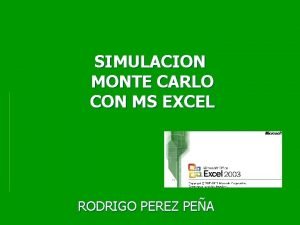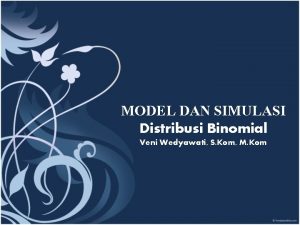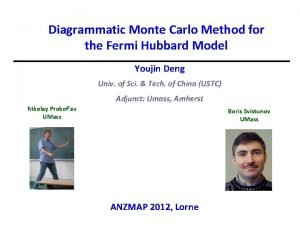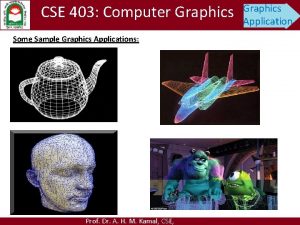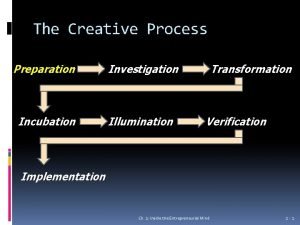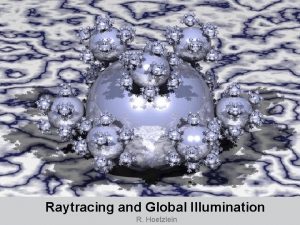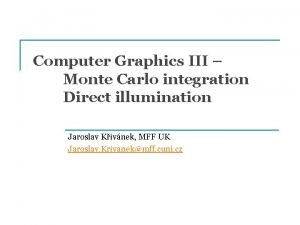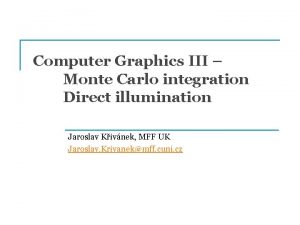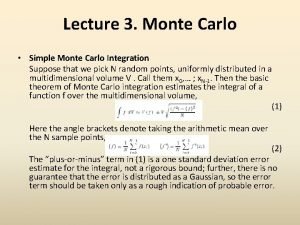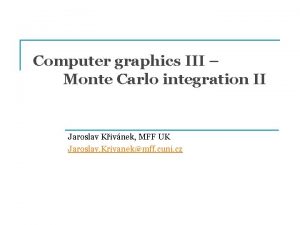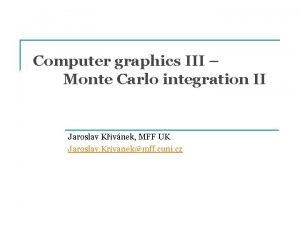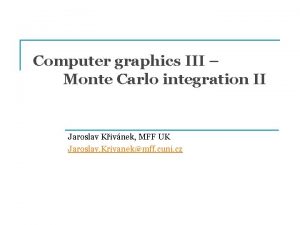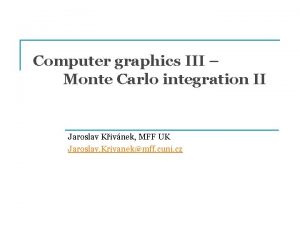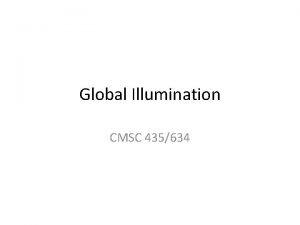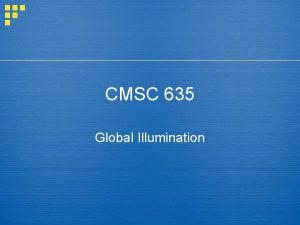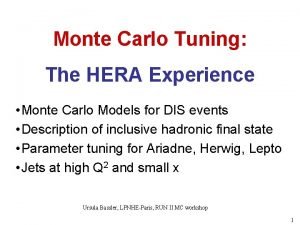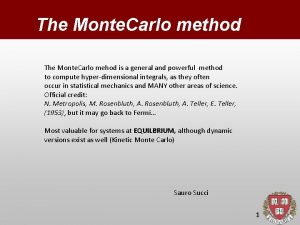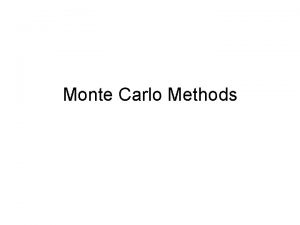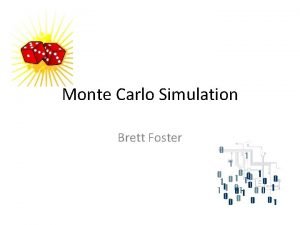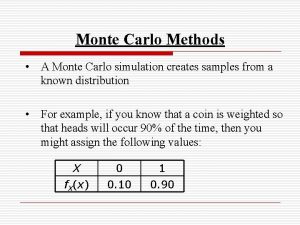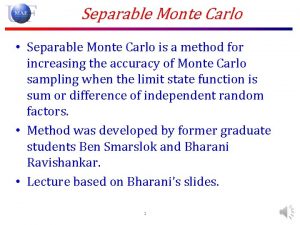Computer Graphics III Monte Carlo integration Direct illumination





























































- Slides: 61

Computer Graphics III – Monte Carlo integration Direct illumination Jaroslav Křivánek, MFF UK Jaroslav. Krivanek@mff. cuni. cz

Entire the lecture in 5 slides

Reflection equation upper hemisphere over x n Lo(x, wo) qo qi Lr(x, wo) CG III (NPGR 010) - J. Křivánek 2015 Li(x, wi) dwi

Rendering = Integration of functions n Problems q q Incoming radiance Li(x, wi) for a point on the floor. Images: Greg Ward q Discontinuous integrand (visibility) Arbitrarily large integrand values (e. g. light distribution in caustics, BRDFs of glossy surfaces) Complex geometry CG III (NPGR 010) - J. Křivánek 2015 4

Monte Carlo integration n General tool for estimating definite integrals Integral: f(x) Monte Carlo estimate I: p(x) 0 5 3 1 4 2 6 1 Works “on average”: CG III (NPGR 010) - J. Křivánek 2015 5

Application of MC to reflection eq: Estimator of reflected radiance n Integral to be estimated: n PDF for cosine-proportional sampling: n MC estimator: CG III (NPGR 010) - J. Křivánek 2015 6

Variance => image noise CG III (NPGR 010) - J. Křivánek 2015 7

… and now the slow way

Digression: Numerical quadrature

Quadrature formulas for numerical integration n General formula in 1 D: f n xi f(xi) wi integrand (i. e. the integrated function) quadrature order (i. e. number of integrand samples) node points (i. e. positions of the samples) integrand values at node points quadrature weights CG III (NPGR 010) - J. Křivánek 2015 10

Quadrature formulas for numerical integration n Quadrature rules differ by the choice of node point positions xi and the weights wi q n E. g. rectangle rule, trapezoidal rule, Simpson’s method, Gauss quadrature, … The samples (i. e. the node points) are placed deterministically CG III (NPGR 010) - J. Křivánek 2015 11

Quadrature formulas in multiple dimensions n General formula for quadrature of a function of multiple variables: n Convergence speed of approximation error E for an sdimensional integral is E = O(N-1/s) q n E. g. in order to cut the error in half for a 3 -dimensional integral, we need 23 = 8 – times more samples Unusable in higher dimensions q Dimensional explosion CG III (NPGR 010) - J. Křivánek 2015 12

Quadrature formulas in multiple dimensions n Deterministic quadrature vs. Monte Carlo q q q n In 1 D deterministic better than Monte Carlo In 2 D roughly equivalent From 3 D, MC will always perform better Remember, quadrature rules are NOT the Monte Carlo method CG III (NPGR 010) - J. Křivánek 2015 13

Monte Carlo

History of the Monte Carlo method n Atomic bomb development, Los Alamos 1940 John von Neumann, Stanislav Ulam, Nicholas Metropolis n Further development and practical applications from the early 50’s CG III (NPGR 010) - J. Křivánek 2015 15

Monte Carlo method n We simulate many random occurrences of the same type of events, e. g. : q q q Neutrons – emission, absorption, collisions with hydrogen nuclei Behavior of computer networks, traffic simulation. Sociological and economical models – demography, inflation, insurance, etc. CG III (NPGR 010) - J. Křivánek 2015 16

Monte Carlo – applications n n n Financial market simulations Traffic flow simulations Environmental sciences Particle physics Quantum field theory Astrophysics Molecular modeling Semiconductor devices Optimization problems Light transport calculations. . . CG III (NPGR 010) - J. Křivánek 2015 17

Slide credit: Iwan Kawrakov CG III (NPGR 010) - J. Křivánek 2015 18

Slide credit: Iwan Kawrakov CG III (NPGR 010) - J. Křivánek 2015 19

Variance => image noise CG III (NPGR 010) - J. Křivánek 2015 20

Monte Carlo integration n General tool for estimating definite integrals Integral: f(x) Monte Carlo estimate I: p(x) 0 5 3 1 4 2 6 1 Works “on average”: CG III (NPGR 010) - J. Křivánek 2015 21

Monte Carlo integration n Samples are placed randomly (or pseudo-randomly) n Convergence of standard error: std. dev. = O(N-1/2) q q n Convergence speed independent of dimension Faster than classic quadrature rules for 3 and more dimensions Special methods for placing samples exist q q Quasi-Monte Carlo Faster asymptotic convergence than MC for “smooth” functions CG III (NPGR 010) - J. Křivánek 2015 22

Monte Carlo integration n Pros q q q n Simplementation Robust solution for complex integrands and integration domains Effective for high-dimensional integrals Cons q q Relatively slow convergence – halving the standard error requires four times as many samples In rendering: images contain noise that disappears slowly CG III (NPGR 010) - J. Křivánek 2015 23

Review – Random variables

Random variable n X … random variable n X assumes different values with different probability q q Given by the probability distribution D X D CG III (NPGR 010) - J. Křivánek 2015 25

Discrete random variable n n n Finite set of values of xi Each assumed with prob. pi Cumulative distribution function Probability mass function Cumulative distribution func. CG III (NPGR 010) - J. Křivánek 2015 26

Continuous random variable n Probability density function, pdf, p(x) n In 1 D: CG III (NPGR 010) - J. Křivánek 2015 27

Continuous random variable n Cumulative distribution function, cdf, P(x) V 1 D: CG III (NPGR 010) - J. Křivánek 2015 28

Continuous random variable Example: Uniform distribution Probability density function (pdf) Cumulative distribution function (cdf) CG III (NPGR 010) - J. Křivánek 2015 29

Continuous random variable Gaussian (normal) distribution Cumulative distribution function (cdf) CG III (NPGR 010) - J. Křivánek 2015 Image: wikipedia Probability density function (pdf) 30

Expected value and variance n Expected value n Variance q Properties of variance (if Xi are independent) CG III (NPGR 010) - J. Křivánek 2015 31

Transformation of a random variable n Y is a random variable n Expected value of Y CG III (NPGR 010) - J. Křivánek 2015 32

Monte Carlo integration

Monte Carlo integration n General tool for estimating definite integrals Integral: f(x) Monte Carlo estimate I: p(x) 0 5 3 1 4 2 6 1 Works “on average”: CG III (NPGR 010) - J. Křivánek 2015 34

Primary estimator of an integral Integral to be estimated: Let X be a random variable from the distribution with the pdf p(x), then the random variable Fprim given by the transformation f(X)/p(X) is called the primary estimator of the above integral. CG III (NPGR 010) - J. Křivánek 2015 35

Primary estimator of an integral f(X) f(x) 0 X CG III (NPGR 010) - J. Křivánek 2015 1 36

Estimator vs. estimate n Estimator is a random variable q It is defined though a transformation of another random variable n Estimate is a concrete realization (outcome) of the estimator n No need to worry: the above distinction is important for proving theorems but less important in practice CG III (NPGR 010) - J. Křivánek 2015 37

Unbiased estimator n n A general statistical estimator is called unbiased if – “on average” – it yields the correct value of an estimated quantity Q (without systematic error). More precisely: Estimator of the quantity Q (random variable) CG III (NPGR 010) - J. Křivánek 2015 Estimated quantity (In our case, it is an integral, but in general it could be anything. It is a number, not a random variable. ) 38

Unbiased estimator The primary estimator Fprim is an unbiased estimator of the integral I. Proof: CG III (NPGR 010) - J. Křivánek 2015 39

Variance of the primary estimator For an unbiased estimator, the error is due to variance: (for an unbiased estimator) If we use only a single sample, the variance is usually too high. We need more samples in practice => secondary estimator. CG III (NPGR 010) - J. Křivánek 2015 40

Secondary estimator of an integral n Consider N independent random variables Xi n The estimator FN given be the formula below is called the secondary estimator of I. n The secondary estimator is unbiased. CG III (NPGR 010) - J. Křivánek 2015 41

Variance of the secondary estimator . . . standard deviation is ÖN-times smaller! (i. e. error converges with 1/ÖN) CG III (NPGR 010) - J. Křivánek 2015 42

Properties of estimators

Unbiased estimator n n A general statistical estimator is called unbiased if – “on average” – it yields the correct value of an estimated quantity Q (without systematic error). More precisely: Estimator of the quantity Q (random variable) CG III (NPGR 010) - J. Křivánek 2015 Estimated quantity (In our case, it is an integral, but in general it could be anything. It is a number, not a random variable. ) 44

Bias of a biased estimator n If then the estimator is “biased” (cz: vychýlený). n Bias is the systematic error of he estimator: CG III (NPGR 010) - J. Křivánek 2015 45

Consistency n Consider a secondary estimator with N samples: n Estimator FN is consistent if i. e. if the error FN – Q converges to zero with probability 1. CG III (NPGR 010) - J. Křivánek 2015 46

Consistency n Sufficient condition for consistency of an estimator: bias n n Unbiasedness is not sufficient for consistency by itself (if the variance is infinite). But if the variance of a primary estimator finite, then the corresponding secondary estimator is necessarily consistent. CG III (NPGR 010) - J. Křivánek 2015 47

Rendering algorithms n Unbiased q q q n Biased & Consistent q n Path tracing Bidirectional path tracing Metropolis light transport Progressive photon mapping Biased & not consistent q q Photon mapping Irradiance / radiance caching CG III (NPGR 010) - J. Křivánek 2015 48

Mean Squared Error – MSE (cz: Střední kvadratická chyba) n Definition n Proposition q Proof CG III (NPGR 010) - J. Křivánek 2015 49

Mean Squared Error – MSE (cz: Střední kvadratická chyba) n If the estimator F is unbiased, then n i. e. for an unbiased estimator, it is much easier to estimate the error, because it can be estimated directly from the samples Yi = f(Xi) / p(Xi). Unbiased estimator of variance CG III (NPGR 010) - J. Křivánek 2015 50

Efficiency of an estimator n Efficiency of an unbiased estimator is given by: variance Calculation time (i. e. operations count, such as number of cast rays) CG III (NPGR 010) - J. Křivánek 2015 51

MC estimators for illumination calculation

Irradiance estimator – uniform sampling n Integral to be estimated: n PDF for uniform sampling: n Estimator: CG III (NPGR 010) - J. Křivánek 2015 53

Irradiance estimator – cosineproportional sampling n Integral to be estimated: n PDF for cosineproportional sampling: n Estimator CG III (NPGR 010) - J. Křivánek 2015 54

Irradiance estimate – light source sampling CG III (NPGR 010) - J. Křivánek 2015 55

Irradiance estimate – light source sampling n Reformulate the reflection integral (change of variables) n PDF for uniform sampling of the surface area: n Estimator CG III (NPGR 010) - J. Křivánek 2015 56

Light source vs. cosine sampling Light source area sampling Cosine-proportional sampling Images: Pat Hanrahan CG III (NPGR 010) - J. Křivánek 2015 57

CG III (NPGR 010) - J. Křivánek 2015 58

CG III (NPGR 010) - J. Křivánek 2015 59

Area light sources 1 sample per pixel 9 samples per pixel CG III (NPGR 010) - J. Křivánek 2015 36 samples per pixel 60

Direct illumination on a surface with an arbitrary BRDF n Integral to be estimated n Estimator based on uniform light source sampling CG III (NPGR 010) - J. Křivánek 2015 61
 Monte carlo method matlab
Monte carlo method matlab Illumination model in computer graphics
Illumination model in computer graphics Count of monte carlo
Count of monte carlo Ulam monte carlo
Ulam monte carlo Contoh kasus simulasi monte carlo
Contoh kasus simulasi monte carlo Mnemstudio
Mnemstudio Kinetic monte carlo python
Kinetic monte carlo python Monte carlo tree search tutorial
Monte carlo tree search tutorial Monte carlo ray tracing
Monte carlo ray tracing Monte carlo localization for mobile robots
Monte carlo localization for mobile robots Minitab monte carlo
Minitab monte carlo Monte carlo simulation advantages and disadvantages ppt
Monte carlo simulation advantages and disadvantages ppt Continuous time monte carlo
Continuous time monte carlo Markov chain monte carlo tutorial
Markov chain monte carlo tutorial Monte carlo localization python
Monte carlo localization python Monte carlo radiation transport
Monte carlo radiation transport Metoda monte carlo algorytm
Metoda monte carlo algorytm Viterbi algorithm
Viterbi algorithm Monte carlo search tree
Monte carlo search tree Monte carlo simulation freeware
Monte carlo simulation freeware Concezio bozzi
Concezio bozzi Monte carlo optimization
Monte carlo optimization Metoda monte carlo
Metoda monte carlo Inverse monte carlo
Inverse monte carlo Villa monte carlo
Villa monte carlo Monte carlo data quality
Monte carlo data quality Alternative to monte carlo simulation
Alternative to monte carlo simulation Self-portrait with beret and gold chain
Self-portrait with beret and gold chain Monte carlo truth
Monte carlo truth Equilikely
Equilikely Monte carlo simulation
Monte carlo simulation Monte carlo exercise
Monte carlo exercise Monte carlo exercise
Monte carlo exercise Quantum monte carlo
Quantum monte carlo The monte carlo
The monte carlo Monte carlo sd
Monte carlo sd Bilangan random adalah
Bilangan random adalah Simulacion monte carlo en excel
Simulacion monte carlo en excel Monte carlo simulation dice roll matlab
Monte carlo simulation dice roll matlab Monte carlo szimuláció példa
Monte carlo szimuláció példa Contoh soal distribusi binomial
Contoh soal distribusi binomial Contoh simulasi monte carlo
Contoh simulasi monte carlo Monte carlo simulation minitab
Monte carlo simulation minitab Diagrammatic monte carlo
Diagrammatic monte carlo Graphics monitors and workstations in computer graphics
Graphics monitors and workstations in computer graphics Introduction to computer graphics ppt
Introduction to computer graphics ppt Slit lamp principle
Slit lamp principle Retro illumination technique
Retro illumination technique Direct illumination
Direct illumination What is the basis of scan conversion of a circle?
What is the basis of scan conversion of a circle? Motion specifications in computer graphics
Motion specifications in computer graphics Cse 403
Cse 403 Dvst stands for
Dvst stands for Hamlet act iii scene ii
Hamlet act iii scene ii Three dimensions of corporate strategy
Three dimensions of corporate strategy Xiaomi bcg matrix
Xiaomi bcg matrix Simultaneous integration meaning
Simultaneous integration meaning Global illumination vray
Global illumination vray Verification in creative process
Verification in creative process Raytracing vs rasterization
Raytracing vs rasterization Darkroom equipment in radiography
Darkroom equipment in radiography Illumination engineering notes pdf
Illumination engineering notes pdf
